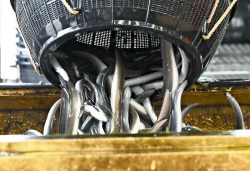
Blue crabs are seen on the shores of Porto Tolle, Italy, in this undated photo.
17:46 JST, August 28, 2023
ROME (Reuters) — A particularly aggressive crab species from the western Atlantic is threatening Italy’s role as one of the world’s top producers of clams — as well as, potentially, one of its signature pasta dishes.
The “blue crab,” originally from the coast of north and south America, has spread across several lagoon-like locations in Italy, preying on local shellfish, fish roe and other aquatic life.
Clam aquafarms in the delta of the Po river valley in northern Italy are particularly hard hit, with a local marine biologist telling Reuters that the crabs have eaten up to 90% of young clams, decimating future production.
“Juveniles have been almost completely preyed on, for sure we will have next year a very big crisis and shortages in the market,” Emanuele Rossetti from the Fishermen’s Cooperative of the Polesine, part of the Po delta area, told Reuters.
Italy is Europe’s biggest producer of clams, and the third largest in the world behind China and South Korea, according to U.N. Food and Agriculture Organization data from 2021.
It is also home to “spaghetti alle vongole” (spaghetti with clams), a classic of Italian cuisine.
Sasa Raicevich, a marine aquatic resources expert from the Italian Institute for Environmental Protection and Research, said the blue crabs are thought to have arrived in Italy via shipping bilge water.
He said they were first detected about a decade ago, and it is still unclear why they are now multiplying with such speed. “There could be a link to climate change, but we have no evidence to say it for sure.”
Fishermen in affected areas have been advised to catch as many blue crabs as possible to curb their numbers, but in the Po delta valley efforts have not made much of a difference.
“Today we caught about 12 tons … we fish these kind of amounts every day, but we don’t see a fall in the [crab] population,” Rossetti said, adding that their numbers started to get out of control in May.
“We are disheartened.”
Only a small proportion of the crabs caught are sold for human consumption, as they are a relative novelty attracting little demand. The rest are disposed of, although there are plans to use some for animal feed purposes.
Last month, farming lobby Coldiretti said the crab “invasion” was turning into a “natural calamity” threatening the survival of 3,000 family firms in the Po delta, and called for government support.
Italy’s agriculture ministry did not immediately respond to a request for comment.
Raicevich, the researcher, said the situation was very serious in terms of ecological and economic damage, and warned there was no possibility of completely eradicating the blue crabs.
“We have to contain them and find ways of coexistence … it’s going to be difficult.”
"Science & Nature" POPULAR ARTICLE
-

Genome Study Reveals Milestone in History of Cat Domestication
-

Big Leap in Quest to Get to Bottom of Climate Ice Mystery
-

Security Camera Footage Vulnerable to Outside Access; Investigation Finds 3,000 Pieces Exposed Online
-

Paws on Parade: Nairobi’s Dogs Dazzle at ‘Pawchella’
-

Japanese Eels Escape New Regulation in Vote at CITES Meeting, Avoiding Higher Prices for Dealers and Diners
JN ACCESS RANKING
-

Keidanren Chairman Yoshinobu Tsutsui Visits Kashiwazaki-Kariwa Nuclear Power Plant; Inspects New Emergency Safety System
-

Imports of Rare Earths from China Facing Delays, May Be Caused by Deterioration of Japan-China Relations
-

University of Tokyo Professor Discusses Japanese Economic Security in Interview Ahead of Forum
-

Japan Pulls out of Vietnam Nuclear Project, Complicating Hanoi’s Power Plans
-

Govt Aims to Expand NISA Program Lineup, Abolish Age Restriction


























